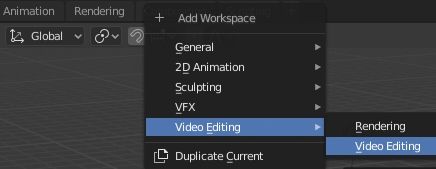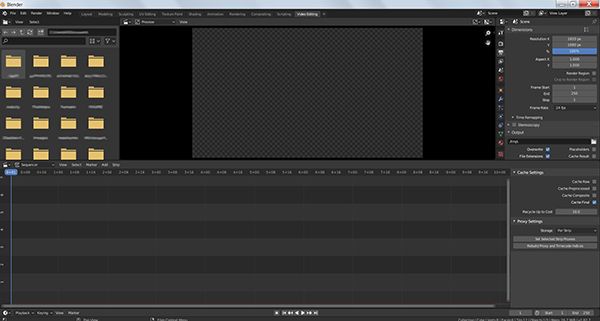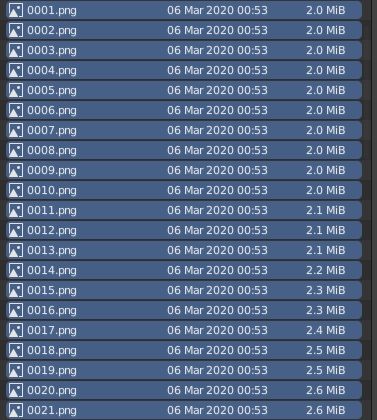How To Save Blender Animation As Mp4
Blender convert a sequence of images into mp4 video
In this tutorial for Blender (updated to Blender ii.8x) we will bear witness you how to convert a sequence of images into an mp4 video for Youtube using the Video Sequence Editor (VSE).
When rendering an blitheness with Blender information technology is advisable non to save information technology immediately as a moving-picture show, merely as a sequence of images (in PNG format, as information technology is the one with the best quality / compression ratio and is compatible with many softwares) and in order to resume rendering from a certain frame onwards in the outcome of a crash, both in order to divide a rendering into several parts, to be carried out comfortably in the nigh user-friendly moments.
Withal, there is a demand to export the video in other formats to evidence it to the public (in a youtube video, on a web folio or even but to view them with a player) or to compress all the animation in a single file of size smaller and more compact.
Upload the image sequence:
To transform the sequence of images, we will use the Video Sequence Editor (VSE), one of the many precious tools contained in Blender, which has many features in common with the all-time professional video editors.
In the top menu we select the "Video Editing" workspace or, if it is not present, we add it by pressing the "+" push button on the right

and we will display the editor with the list of directories, the preview of the video, the Properties Window, the channels of the Video Sequencer and the panel with the properties of the currently selected instrument

When nosotros render an blitheness, the files will exist inserted in the directory whose path is indicated in the "Output Properties" tab, in the Properties Window at the superlative right, in the "Output" subpanel.

We add the sequence of images by selecting, in the menu above the channels of the Video Sequencer, Add > Prototype/Sequence

so the popup window volition open to import the files and we select the directories whose path we had noted before in the properties

We now select the images to exist imported, nosotros take different modes available:
-
Selecting all the images past pressing the A key (a useful method, which can exist implemented without problems if in the directory there are merely the files we want to upload)

- Using the rectangle selection tool, activated by pressing the "B" central, we can select but the files that interest us
-
Selecting part of the images with the keyboard: click on the first file and, property downwards the SHIFT key, click on the last

On the right are the import options, nosotros leave the default options unchanged: Start Frame:one, End Frame:26, Aqueduct:2 and immediately press the lesser button "Add together Image Strip".

In this example we accept loaded a number of frames so that it is equal to the value of "End Frame" (26); if it had been smaller, a filling surface area on the right of size = End Frame - number of loaded frames would take been created.
The Frame Rate is gear up to 24 frames per second, so the sequence of 26 images is longer than ane+00, that is longer than a 2nd, also we can see that it has been positioned in aqueduct number ii. The Start Frame value indicates the position where the frames will be placed in the channel.
Catechumen the image sequence to an mp4 video file for Youtube with Blender in the Video Sequence Editor:
Once the sequence of images has been imported, we try to convert it into a single mp4 file, which tin eventually be uploaded to Youtube. We therefore use the Backdrop Window options that we can find in the panel at the top right.

We select the "Output Backdrop" tab and in the "Dimensions" subpanel we prepare the dimensions that the movie must accept; these may correspond to the dimensions of the images in the sequence, or to the dimensions of the movie we want to create (for example, if nosotros desire to export the movie to upload it to Youtube, a good resolution could be 1920x1080). We also set the duration or portion of the animation in frames and the frames per second of the blitheness (24 or 25 frames per second should be fine for common viewing, simply for movies where you desire to relieve you lot can get upwards to 15 fps, while for movies with fast animations you can gear up sixty fps)
In the "Output" sub-panel we open the "File Format" drop-down menu and we come across that at that place are various formats, both image and video; select "FFmpeg video" which volition provide us with the features offered by the FFmpeg video conversion software (if you lot desire to use it in standalone mode for other purposes, you tin download information technology from https://www.ffmpeg.org/, but in our example it is already included in Blender)

All the formats supported past FFmpeg regarding the container appear, the video codec and the audio codec

If we open the Encoding > Container drop-downwards bill of fare nosotros can see the list of containers made available by FFmpeg

for each container nosotros cull, a different list of "Video Codec" or unlike options associated with the single container will appear, in cases where there is a 1:i correspondence between the codec and the container.
For case, if we choose MP4 as a container, we tin choose betwixt these codecs

and related codecs (AAC is recommended for Youtube) for a possible audio file,

which can be loaded and placed in some other channel past selecting the Add together > Sound command in the VSE card

Close to the give-and-take "Encoding" you can click on a button that allows the selection of some presets, useful for speeding up some operations. For example, if we want to upload the video file to Youtube, we can cull a format with MP4 container and H.264 video codec, and so only select "h264 in MP4"

Returning to look at the other video options:

"Output Quality" indicates the quality that the moving picture must have, we recommend the "Medium quality" value for the tests and "Loftier quality" for the concluding version. If you don't desire to lose any detail you can choose "Lossless" (without loss of data, simply the file afterwards volition be much larger).
"Encoding Speed" indicates the encoding speed: greater coding accuracy will take longer, but the encoded file will exist smaller.
Once the settings for exporting the video have been completed, nosotros check that the "Sequencer" option is checked in the "Mail Processing" sub-panel,

so to start coding nosotros press CTRL+F12 or select in the card Return > Render Animation, as when we outset rendering the blitheness,

and, when finished, a new file will be created in the output directory whose name will take into account the imported frames and the called format, for example "0001-0026.mp4".
Here ends the tutorial for Blender to catechumen a sequence of images to mp4 video, so you can show your fantastic animations made with Blender on Youtube, the process is fast plenty, but you have to pay attention to the codecs, perchance installing costless packages like K-Light (Windows) and good players like VLC Media Player. Happy blending!
Source: https://www.graphicsandprogramming.net/eng/tutorial/blender/the-video-sequence-editor/blender-convert-sequence-images-mp4
Posted by: clarkeblamot.blogspot.com



0 Response to "How To Save Blender Animation As Mp4"
Post a Comment